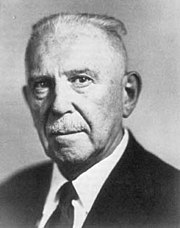Solomon Lefschetz
| Solomon Lefschetz | |
|---|---|
 |
|
| Born |
3 September 1884 Moscow, Russian Empire |
| Died | 5 October 1972 (aged 88) Princeton, New Jersey, U.S. |
| Nationality | American |
| Fields | Algebraic topology |
| Institutions |
University of Nebraska University of Kansas Princeton University |
| Alma mater |
École Centrale Paris Clark University |
| Doctoral advisor | William Edward Story |
| Doctoral students |
Edward Begle Richard Bellman Felix Browder Clifford Dowker George F. D. Duff Ralph Fox Ralph Gomory John McCarthy Robert Prim Paul A. Smith Norman Steenrod Clifford Truesdell Albert W. Tucker John Tukey Henry Wallman Shaun Wylie |
| Known for |
Lefschetz fixed point theorem Picard–Lefschetz theory Lefschetz connection Lefschetz hyperplane theorem Lefschetz duality Lefschetz manifold Lefschetz number Lefschetz zeta function Lefschetz pencil Lefschetz theorem on (1,1)-classes |
| Notable awards |
Bôcher Memorial Prize (1924) National Medal of Science (1964) Leroy P. Steele Prize (1970) Fellow of the Royal Society |
Solomon Lefschetz (Russian: Соломо́н Ле́фшец; 3 September 1884 – 5 October 1972) was an American mathematician who did fundamental work on algebraic topology, its applications to algebraic geometry, and the theory of non-linear ordinary differential equations.
He was born in Moscow into a Jewish family (his parents were Ottoman citizens) who moved shortly after that to Paris. He was educated there in engineering at the École Centrale Paris, but emigrated to the USA in 1905.
He was badly injured in an industrial accident in 1907, losing both hands. He moved towards mathematics, receiving a Ph.D. in algebraic geometry from Clark University in Worcester, Massachusetts in 1911. He then took positions in University of Nebraska and University of Kansas, moving to Princeton University in 1924, where he was soon given a permanent position. He remained there until 1953.
In the application of topology to algebraic geometry, he followed the work of Charles Émile Picard, whom he had heard lecture in Paris at the École Centrale Paris. He proved theorems on the topology of hyperplane sections of algebraic varieties, which provide a basic inductive tool (these are now seen as allied to Morse theory, though a Lefschetz pencil of hyperplane sections is a more subtle system than a Morse function because hyperplanes intersect each other). The Picard–Lefschetz formula in the theory of vanishing cycles is a basic tool relating the degeneration of families of varieties with 'loss' of topology, to monodromy. His book L'analysis situs et la géométrie algébrique from 1924, though opaque foundationally given the current technical state of homology theory, was in the long term very influential (one could say that it was one of the sources for the eventual proof of the Weil conjectures, through SGA7 also for the study of Picard groups of Zariski surface). In 1924 he was awarded the Bôcher Memorial Prize for his work in mathematical analysis.
...
Wikipedia
